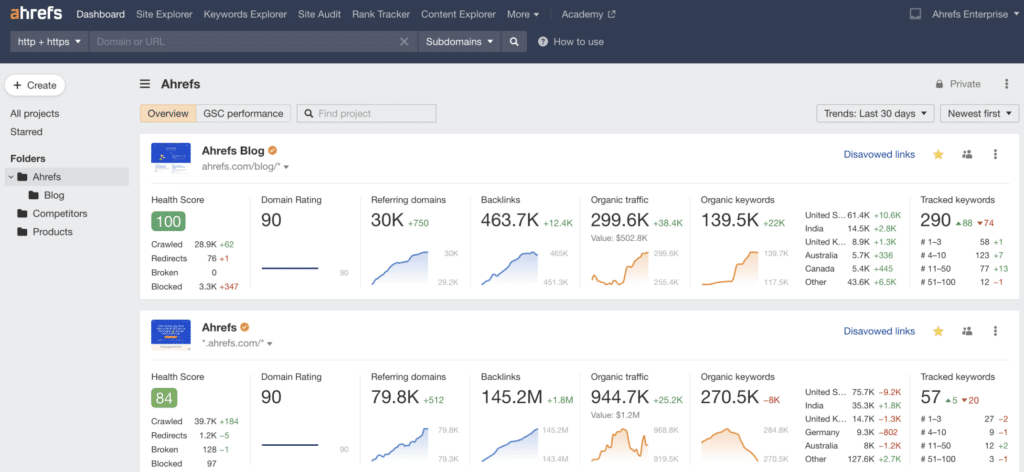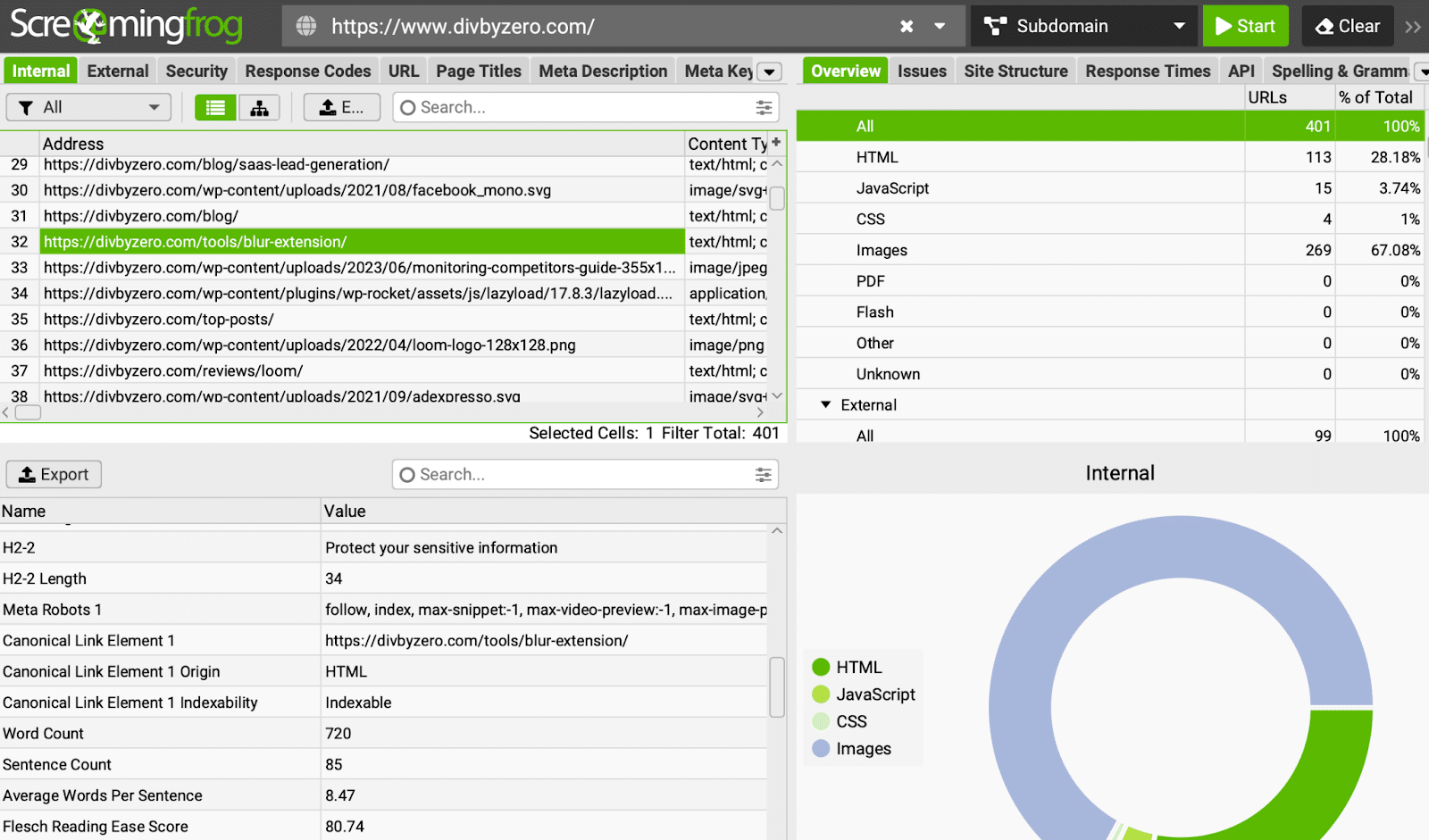How to Conduct a SaaS Content Audit

SaaS content marketing is one of the most common inbound marketing strategies in the industry. Brands understand the potential value that content marketing can offer, and they invest heavily in blog posts, lead magnets, webinars, and videos.
They’ll put enormous time and energy into their content strategy and ongoing creation and management… but so many forget (intentionally or unintentionally) about the all-important content audit.
A SaaS content audit is admittedly a time-consuming and sometimes dreaded part of marketing, but it’s an essential one for long-term success. In this post, we’re going to show you how to conduct a SaaS content audit that’s thorough, accurate, and (most importantly) actionable— with a free content audit template to get you started!
What is a SaaS Content Audit?
A SaaS content audit is a thorough and systemized analysis of your SaaS brand’s entire inventory of content to assess performance and identify new opportunities.
A thorough SaaS content audit is extremely thorough— you don’t just look at a few performance metrics like bounce rate or clicks (though those absolutely matter), but you look for why certain types of content perform well.
The goal is to gain immense insight into how your strategy is working overall, discover what types of content perform well and why, and identify new opportunities for content creation or updating that can benefit you further.
Who Conducts a SaaS Content Audit?
A SaaS content audit is typically conducted by one or more members of your marketing team, though if you’re working with an external content strategist or agency, this may be a service that they offer. Some prefer to have an external service do the work because it’s so time-consuming; even with content audit tools (which we’ll discuss), some manual review is necessary.
If you don’t want to go through the painstaking work of conducting the audit thoroughly, outsourcing may be a good call, but the process is relatively simple and anyone with knowledge of your content strategy and an eye for detail could do the work.
Why Are Content Audits Important?
Content audits are essential to a strong content strategy and effective content marketing long-term.
Without content audits, you aren’t able to get into the nitty-gritty to really determine what’s working well, why it’s working, and what you can do to optimize your strategy and the content itself moving forward.
You may notice some trends on your own without a content audit like that long-form posts rank well or that controversial posts get a ton of engagement and social shares.
You’re less likely to notice that certain categories of content may have slightly lower traffic but higher conversion rates, or that your posts with videos embedded in them have a lower bounce rate. That’s what you need a content audit for.
While we can all follow carefully laid-out best practices and create a detailed content strategy, a content audit is the only way to know for sure how well those practices and strategies are working.
Just as importantly, a content audit not only provides clarity about your current marketing performance, but it provides an opportunity to revamp both your strategy and existing content as needed.
You may discover that some previously-performing content isn’t ranking or performing well anymore, and realize that a change in Google’s algorithms or evolved best practices mean that those posts need to be updated or even rewritten entirely. One part of your strategy may need to be changed or even stopped, and some content distribution channels may not be worth the effort anymore.
There’s no getting around it: You need content audits for SaaS marketing strategies.
How to Conduct a SaaS Content Audit
Ready to conduct your own SaaS content audit? Let’s go step by step through the process to get you actionable insights.
1. Review Your Strategy & Determine Your Goals & KPIs
The first thing you need to do is to take a quick review of your current goals and key performance indicators (KPIs).
You can’t assess the performance of your campaigns if you don’t even know what you’re measuring for or how you plan to evaluate success.
So, at this stage, do the following:
- Review the strategy that you’ve been using, if you’ve already been working with content marketing and you aren’t starting from scratch
- Consider the goals that you were optimizing for
- Determine what goals you want to optimize for moving forward, and if they’re aligned with past goals
- Choose KPIs that will help you assess content for the goals you have in mind
If you realize that you’ve been targeting search traffic exclusively but you also now want to add a goal of sending users to sign-up for free trials, you’re going to want to monitor bounce rate and CTA click rates more closely instead of just watching for monthly impressions.
Document your new goals and the KPIs you plan to use— you may want to add these to the content audit template you’re using if they aren’t there already.

2. Consider What Types of Content You Have
Before you start the actual audit, you want to take a minute to think about the types of content that you have and what you should include in the audit. You’ll also want to ensure at this point that each type of content has goals and KPIs assigned to it.
Many SaaS content marketing strategies are centered around blogs and lead magnets, so that’s likely your focus. But you may also have the following types of content (beyond blog posts) to consider:
- Webinars
- Video marketing, including on your YouTube channel
- Guest posts on third-party websites
- Content that was created for the sales team to use, including brochures or pitch decks
- Long-form social media posts, especially with LinkedIn advertising or marketing
Create an inventory of all of your content so that you can audit it properly.
3. Take Stock of Your Entire Content Inventory
You know what types of content you have and where it lives, so now it’s time to start plugging the content into a template along with its performance for easy analysis. This is easily the most time-consuming part of the content audit process, but it’s also the most important, so it is worth it.
If you have a relatively small inventory of content, you can do this entirely manually. Use a content template like ours (which is linked a few sections down with an explanation of how to use it!) and add crucial information for each type of content.
For blog posts, you’ll want to track:
- Content type
- Post Title
- URL
- Topic cluster or content category
- Word count
- Post format and media used
- CTA action optimized for
- Stage of the funnel
- Targeted keyword
- Distribution strategies used
You’ll want to assess performance with metrics like:
- Monthly impressions
- Bounce rate
- Clicks on CTA
- Time spent on page
- Social shares
- Page position in the SERPs
For video, you may want to track:
- Video length
- Video topic
- URL
- Distribution strategies
- Video format
- CTA action
And assess performance with metrics like:
- Number of monthly views
- Methods of discovery
- Video completion rates
- Watch time
- Engagement
Tools & Data Sources for SaaS Content Audits
You’ll want to use multiple data sources as needed to get this information.
Google Analytics can tell you some, including bounce rates, time spent on a page, and how many users click on your in-post CTA.

Ahrefs can help you track which keywords you’re ranking for and how you’re ranking for each keyword you’re targeting, with your position in the SERP. It can also provide your potential and true monthly traffic.

Screaming Frog is the best content audit tool on the market. It will let you analyze up to 500 URLs completely for free, but the paid plan is definitely worth if if you have a larger inventory. It will show you each post’s word count, meta description (and character count), readability, number of unique links, and more. If you want to ensure that your blog is maintaining certain standards— like at least four internal backlinks per post or eight links total— this tool can help monitor that.

Drop the essential information for your KPIs into your content template as you go. If you’re using a tool like Screaming Frog, you can also download the report and then add additional fields of information as needed.
4. Create an Organized Report
Once you have your content in place, you may need to clean up the data a bit. Our template was created with that in mind, but you may still need to organize it based on the order of the data that you imported.
It often makes sense, for example to group content by category so that you can easily spot differences in content between and within different categories. Having lead magnets mixed in with blog posts can be confusing, but it’s also hard to evaluate different content pillars if they’re all jumbled together in the report.
Make sure that it’s easy to read and share, and consider any essential information that you may need.
5. Review the Data
Now it’s time to analyze the data in question. With a well-organized content audit report, this is much easier.
First, look at posts that are performing well, and then consider what they have in common. You can peek back into Screaming Frog to look for more details that you may not have in the audit, like the meta descriptions or number of images to look for more detailed trends if they aren’t readily available from the data you’ve tracked so far.
Then, look at posts that aren’t doing so well. Is there a clear reason why, like they were published two years ago and may be either outdated or surpassed by the competition?
Trends are a big deal here and can help you piece together a great deal about what’s working and what isn’t with your content strategy. You must do this manually, even reviewing specific posts in detail if needed to gain the insight you need.
Make sure that you’re also evaluating the impact of different distribution strategies. If you paid to promote some posts with outbound marketing and it’s clearly paying off, that may be a strategy you want to continue. And if some posts do well on social media but others don’t, that’s worth taking note of— you can create more content specifically to share on social, and focus on other distribution methods for the other content types.
6. Reassess Your Strategy
Now that you’ve seen the data, you can answer the question “is my SaaS content strategy working?”
There’s a good chance that the answer may be some yes and some no. There may be some posts that just aren’t taking off or ranking as well as you expected; that’s fine, sometimes there’s a bit of a swing and a miss involved with any kind of marketing. But you should have more “yes” than “no,” and you want to reinvest into what’s working and either rework or let go of what isn’t.
Sometimes this might be an entire strategy, like using glossary-style content, and in other cases, it might be a specific type of post (like “industry updates” or product-centered tutorials).
7. Identify Posts That Need to Be Updated
During your content audit, there’s a good chance that you’ve found some content that just isn’t performing how it used to be, or how you’d expect it to perform.
It’s important to look at why.
A tool like Ahrefs will help you track your content’s positions for the keywords you’re ranking for, which is a great first start.
Look at which posts are getting the least traffic, and which are falling in the SERPs. And if there are high-value posts, assess them individually to see if their performance is where you think they should be.
When you’ve got a list of these posts, you can determine what actions you want to take next:
- Do the posts just need updated information that reflects modern opinions, technology, or strategies?
- Have content best practices changed and a significant overhaul or addition is needed?
- Is some content so irrelevant that you want to delete it altogether?
Refreshing blog posts should be a core part of your strategy once you’ve been investing in content marketing for a year, so don’t forget this part of the audit.
Our Free Content Audit Template
As we’ve discussed above, there are plenty of content audit tools SaaS brands can use to streamline the process, especially if they have a large content inventory. That being said, manual review is always going to be necessary— most of these tools won’t track information like what topic cluster a post belongs to or what type of video format you used.
That’s why we strongly recommend importing data into a specialized template designed to help you assess all of the information at once. To help, we’ve created a free SaaS content audit template.

Note that the template is set to “view only.” To get your template, select “File” at the top of the document, and then “Make a copy.” You’ll have your own content audit template to customize and fill out as you see fit!

How Often Should I Conduct a Content Audit
There are a few specific events that require a SaaS content audit:
- You’re creating a new content strategy
- You need to assess your current strategy
- You’re making big marketing decisions, including about budget, output, and different platforms
- You want to roll out a new type of content, like video marketing or webinars
- You’ve noticed from basic analytics that your site traffic or results aren’t where you wanted them to be, or that performance seems to be decreasing
Any of these instances indicate that you need to check in on your existing content performance with an audit to make sure that you’re headed in the right direction.
Sometimes, though, none of these things have happened recently and aren’t due to happen any time soon. If that’s the case, you’ll want to conduct a thorough content audit at minimum once a year; checking in once every six months, however, is ideal. That gives the content enough time to gain momentum and show you the early impact of the strategy while making sure you’re not barking up the wrong tree for too long.
Final Thoughts
Conducting a SaaS content audit is an integral part of your overall content marketing strategy. It’s the only way to get actionable and accurate insight into what’s working and (most importantly), why. There are so many nuanced aspects of content marketing that only a content audit can help you unpack all the layers to get a good read on what’s happening and to help you plan for the coming year.
Ready to get started with your audit? Get access to our free SaaS content audit template here.


